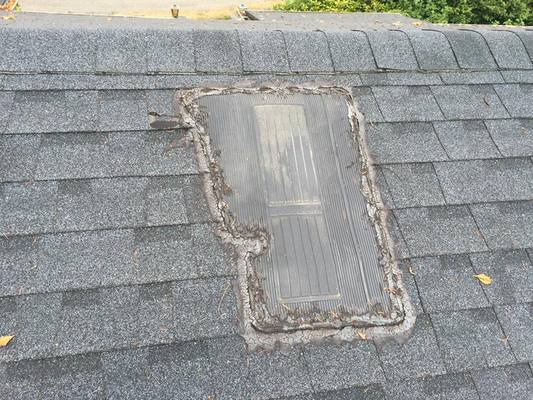
Right and Wrong Roofing Procedures.
Below are some basic terms and the meaning of those term for the roofing trade. Take a look and get a little knowledge on roofing before you talk to a roofer.
A roof is a big investment, do not cut corners!
One of the main reasons for a leaky roof is the use of staples during the shingle installation. As the roof ages and flexes with the weather (snow load and wind) the top of the staple rubs the back of the shingle and eventually works its way up through the shingle. A roofing nail has a flat head of about 3/8 of and inch, while a staple is about 1/32 of an inch.
Pipe Jacks.
Many of the repairs that our companies go out on are caused by improper or worn out pipe Jacks.
Wall step shingles.
When it comes to a total roof replacement, it is best to replace the wall step shingles with new metal step shingles. As the roofers remove the multiple layers of the old roofing the level of the roofing material drops (If you remove 1 layer of comp roofing and 1 layer of cedar shake the roof height will drop about 1 1/2″) this means the metal step shingles that are behind the siding of the house is no longer flush with the top of the roof. A roof is a big investment, do not cut corners!
Plywood sheeting.
Replacing your roof can be a very expensive project. One of the issues you could have is mold in the attic if you had a leak. As time goes by the plywood sheeting on your roof, this is the base that the roofing shingles are attached to, can become soft or even rotten. Installing a new roof on the top of bad sheeting is like installing it on a sponge. There is nothing to nail the roofing shingles into. Many roofs that we see that are in need of repair are due to this. A good wind storm can remove a whole area of roofing do to this problem. So if your roofer says you need to replace some or all the sheeting on the roof you should listen to them. A roof is a big investment, do not cut corners!
Roof Recovers.
A option when you meet with your roofer may be a recover. This is when a new roof is installed over the top a the old roof. I have many issues with this. The biggest issue is not having any idea of what you are nailing to . The reason you are getting a new roof is probably because you had a leak or the roof is just old. With that being said the sheeting under the roof may be bad. If you drive down the street look at other roofs you may see many houses that have different layers of roofing exposed or even big areas that have been repaired it is more then likely due to a recover. Many roofing companies will not warranty a recover. Especially if you are on the east side of Portland or in the Gorge where the wind blows. A roof is a big investment, do not cut corners!
Valley Metal.
We have seen many different Technics when it comes to a valley in a roof.
We have found that here in Oregon the best method for the valley is a open metal valley. As all roof valleys catches leaves and fir needles, a open metal valley will not catch as many as a valley that is covered with the shingles.
The other trouble that we have found with valleys of a roof is most people when they walk up a roof they tend to walk up the valley, nothing wrong with that but we have repaired many shingled valleys do to someone stepping through the roofing in a spot in the valley where the roofing is not making contact with the sheeting.
A open metal valley will add cost to your new roof (about $50 every 10′ of valley) but closed valleys are one of the main roof repairs from holes in the valley to a improperly installed closed valleys. The next best would be a weaved valley. The one side cut valley is not the best valley for our rainy and windy Oregon weather. As you can see in the photos below rain water runs down the roof and when it hits the open metal valley there is no restrictions,and the rain water can flow smoothly down the valley.
Test your Roofers knowledge.
One way you can test your roofers knowledge of his job: Ask them if they are cutting the tabs in the valley. If they say sure with a question on there face ask them why the tab needs to be cut.
Answer: If the tab is not cut, the rain water can be diverted by the uncut tab as it goes down the valley, once this happens the water will follow along the top of the shingle (under the top layer of roofing) until it finds a way down hill and it will be under the roofing shingle. This will cause A LEAK.